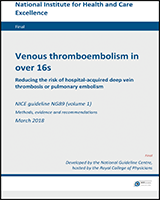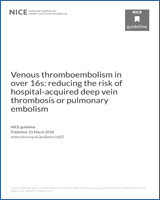NCBI Bookshelf. A service of the National Library of Medicine, National Institutes of Health.
National Guideline Centre (UK). Venous thromboembolism in over 16s: Reducing the risk of hospital-acquired deep vein thrombosis or pulmonary embolism. London: National Institute for Health and Care Excellence (NICE); 2018 Mar. (NICE Guideline, No. 89.)
December 2019: In recommendation 1.3.5 the British Standards for anti-embolism hosiery were updated because BS 6612 and BS 7672 have been withdrawn. August 2019: Recommendation 1.12.11 (1.5.30 in this document) was amended to clarify when anti-embolism stockings can be used for VTE prophylaxis for people with spinal injury.

Venous thromboembolism in over 16s: Reducing the risk of hospital-acquired deep vein thrombosis or pulmonary embolism.
Show detailsMarch 2018
This guideline is a partial update of NICE guideline CG92 (published January 2010) and will replace it. All chapters in CG92 have been updated in this guideline, except for the following 3 chapters which have been carried over:
- Mechanical VTE prophylaxis – anti-embolism stockings
- Nursing care: early mobilisation and hydration
- Anaesthesia.
New recommendations have been added on the risk assessment and prevention of VTE.
Recommendations are marked as [2018] if the recommendation is new or the evidence has been reviewed.
NICE proposes to delete some recommendations from the 2010 guideline, because either the evidence has been reviewed and the recommendations have been updated, or NICE has updated other relevant guidance and has replaced the original recommendations. Recommendations that have been deleted or changed sets out these recommendations and includes details of replacement recommendations. Where there is no replacement recommendation, an explanation for the proposed deletion is given. Recommendations not listed in this section that were in the 2010 guideline have been part of an evidence review and are listed in the main list of recommendations. These are labelled as [2018].
Where recommendations are shaded in grey and end [2010], the evidence has not been reviewed since the original guideline.
Where recommendations are shaded in grey and end [2010, amended 2018], the evidence has not been reviewed but changes have been made to the recommendation wording that change the meaning (for example, because of equalities duties or a change in the availability of medicines, or incorporated guidance has been updated). These changes are marked with yellow shading, and explanations of the reasons for the changes are given in ‘Recommendations that have been deleted or changed’ for information.
Recommendations that have been deleted or changed
Table 322Recommendations to be deleted
| Recommendation in 2010 guideline | Comment |
|---|---|
Base the choice of mechanical VTE prophylaxis on individual patient factors including clinical condition, surgical procedure and patient preference. Choose any one of:
| This recommendation has been deleted because the type of mechanical prophylaxis has been specified in each population recommendation. |
| Show patients how to use anti-embolism stockings correctly and ensure they understand that this will reduce their risk of developing VTE. (1.3.10) | This recommendation has been deleted because it is a duplication of information in recommendations 1.3.2 and 1.2.6. |
| Base the choice of pharmacological VTE agents on local policies and individual patient factors, including clinical condition (such as severe renal impairment or established renal failure) and patient preferences. (1.3.14) | This recommendation has been deleted as it is now covered in population specific recommendations, a generic recommendation about balance risk, and a renal impairment recommendation. |
| Assess the risks and benefits of stopping pre-existing established antiplatelet therapy 1 week before surgery. Consider involving the multidisciplinary team in the assessment. (1.5.2) | This recommendation has been deleted because the committee noted that now an advanced decision can be made about whether to stop antiplatelet therapy. It does not need to be made 1 week before surgery. |
| Consider offering temporary inferior vena caval filters to patients who are at very high risk of VTE (such as patients with a previous VTE event or an active malignancy) and for whom mechanical and pharmacological VTE prophylaxis are contraindicated (1.2.4) | This recommendation has been deleted partly for two reasons: 1. vena caval filters are considered as a method of prophylaxis in individual population reviews. No evidence was identified to support a recommendation for their use. 2. Evidence used in CG92 related to secondary prevention of VTE which is excluded from this update. |
| Do not offer foot impulse or neuromuscular electrical stimulation devices for VTE prophylaxis to patients who are admitted for stroke, except in the context of research (1.4.4) | This recommendation has been deleted because there is a lack of evidence suggesting harm with these devices. |
Table 323Amended recommendation wording (change to meaning)
| Recommendation in 2010 guideline | Recommendation in current guideline | Reason for change |
|---|---|---|
1.3.2 Do not offer anti-embolism stockings to patients who have:
| 1.3.1 Do not offer anti-embolism stockings to people who have:
| Minor edits to clarify meaning. |
| 1.3.9 Discontinue the use of anti-embolism stockings if there is marking, blistering or discolouration of the skin, particularly over the heels and bony prominences, or if the patient experiences pain or discomfort. If suitable, offer a foot impulse or intermittent pneumatic compression device as an alternative. [2010] | 1.3.9 Stop the use of anti-embolism stockings if there is marking, blistering or discolouration of the skin, particularly over the heels and bony prominences, or if the person experiences pain or discomfort. If suitable, offer intermittent pneumatic compression as an alternative. [2010, amended 2018] |
‘Discontinue’ changed to ‘stop’ for plain English purposes, and ‘patient’ changed to ‘person’. The words ‘Foot impulse’ and ‘devices’ were deleted from recommendations because the committee noted that the term intermittent pneumatic compression covers both sleeves applied to the legs and garments wrapped around the foot. The options are considered equal in the recommendations the committee left it to clinicians to decide which were most suitable. |
| 1.3.12 Do not offer foot impulse or intermittent pneumatic compression devices to patients with a known allergy to the material of manufacture. [2010] | 1.3.10 Do not offer intermittent pneumatic compression to people with a known allergy to the material of manufacture. [2010, amended 2018] | The words ‘Foot impulse’ and ‘devices’ were deleted from recommendations because the committee noted that the term intermittent pneumatic compression covers both sleeves applied to the legs and garments wrapped around the foot. The options are considered equal in the recommendations the committee left it to clinicians to decide which were most suitable. |
| 1.3.13 Encourage patients on the ward who have foot impulse or intermittent pneumatic compression devices to use them for as much of the time as is possible and practical, both when in bed and when sitting in a chair. [2010] | 1.3.11 Advise the person to wear their device for as much time as possible. [2010, amended 2018] | Edited to simplify wording. |
| 1.4.2 Do not offer anti-embolism stockings for VTE prophylaxis to patients who are admitted for stroke. [2010] | 1.3.19 Do not offer anti-embolism stockings for VTE prophylaxis to people who are admitted for acute stroke. [2010, amended 2018] | ‘Stroke’ was changed to ‘acute stroke’ to make it clear the recommendation is about someone currently experiencing a stroke or being treated for stroke, not people receiving rehabilitation treatments for stroke. ‘Patients’ was changed to ‘people’. |
Table 324Changes to recommendation wording for clarification only (no change to meaning)
| Recommendation numbers in current guideline | Comment |
|---|---|
| 1.3.2 | Change made from passive to active text. |
| 1.3.2, 1.3.3, 1.3.6, 1.3.7, 1.3.12, 1.3.14, 1.3.20, 1.3.55 | Changes made from ‘patients’ to ‘people’. |
- How this guideline was updated - Venous thromboembolism in over 16sHow this guideline was updated - Venous thromboembolism in over 16s
Your browsing activity is empty.
Activity recording is turned off.
See more...
